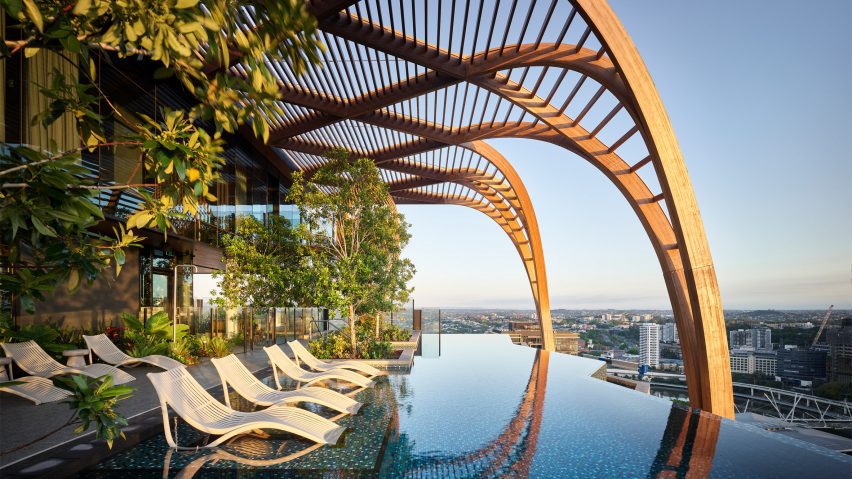Australian studio Koichi Takada Architects has completed Upper House, a 33-storey high-rise in Brisbane designed to reflect the city's tropical setting and First Nations history.
Upper House contains 188 apartments and 1,000 square metres of communal amenities behind a winding timber facade described by Koichi Takada Architects as "architectural roots".
"The Brisbane lifestyle is enviable and unique, and we wanted to celebrate the sub-tropical climate and natural landscape with Upper House, which is designed to breathe," said studio founder Koichi Takada.
"High-rise lifestyle has become so detached and disconnected – from the community, from nature, from one another," he continued. "With Upper House, we are looking to challenge that and establish a new model for vertical living that is, at its foundation, about connection."
At the base of the building is a five-storey podium containing parking. It is covered in artwork by local artist Judy Watson, which acknowledges Upper House's position on the traditional land of the Turrbal Tribe.
Named Bloodlines weaving string and water, the backlit metal artwork "represents Aboriginal walking tracks and local waterways", Takada said.
"Now, more than ever, we understand the importance of respecting and acknowledging our rich history in Australia, home to the oldest known civilisation on earth," explained Takada.
"This prominent expression of indigenous history lays the foundation of respect and opens a dialogue about Australia's globally significant past."
Upwards from the podium, the tower's facade is decorated by three meandering timber pillars intended to mimic the buttress roots of the native Moreton Bay Fig tree.
The structure was achieved in association with timber specialist Theca Australia and is made from Siberian Larch.
"We always turn to nature for inspiration," Takada explained. "The 'architectural roots' map out a journey [that] functions to stabilise and anchor the tree – or in this case building – to its prime location."
Apartment balconies are offset to follow the "roots" as they climb the building's facade, while also providing views towards both the city and distant mountains.
Culminating in a double-height pergola at the crown of the building, the timber system folds over Upper House's wellness club and resident facilities, which span the two upper rooftop levels.
Named the Upper Club, its facilities include a gym, day spa, pool and yoga room in addition to a bar, lounge, dining space, work areas, cinema and wine cellar, all intended to encourage interaction between residents.
"A state-of-the-art wellbeing retreat and social hub are gravitational spaces which all directly address what is referred to as 'connection deficit'," said Takada.
Two raised timber "nests" are placed within the open pergola for small gatherings and are surrounded by extensive landscaping irrigated by harvested rainwater.
"Upper House is crowned with biodiverse outdoor areas," Takada said. "3,544 native and tropical plantings, carefully selected for their ability to thrive in the Queensland climate, ensure a resilient landscape and mini ecosystem that adds vitality to the rooftop setting."
Upper House was designed by Sydney-based Koichi Takada Architects for developer Aria Property Group, with which it previously collaborated on the design for the "world's greenest residential building".
Elsewhere, the studio has also created a mixed-use tower scheme in Sydney with an arched brick podium and an apartment block in Queensland referencing the form of a pine cone.
The photography is by Mark Nilon unless otherwise stated.

